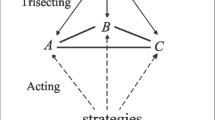Abstract
Clustering by fast search and find of density peaks (DPC) is a popular clustering method based on density and distance. In DPC, each non-center point’s cluster label is led by its nearest point with higher density, which may cause some misclassifications of non-center points and interfere with the choice of correct cluster centers in the decision graph. To avoid these defects, we propose a novel clustering algorithm that automatically generates clusters without using the decision graph based on the Normal-neighbor and Merging force (NM-DPC). We conduct a series of experiments on various challenging synthetic datasets. Experimental results demonstrate that NM-DPC can better identify clusters of complex shapes and automatically recognize the number of clusters.













Similar content being viewed by others
References
Jain AK (1999) Data clustering: a review. ACM Comput Surv 31(3):264–323
Hansen P, Jaumard B (1997) Cluster analysis and mathematical programming. Math Program 79(1–3):191–215
Xu R, Wunsch D II (2007) Computational intelligence in clustering algorithms, with applications
Xu R, Wunsch DC (2010) Clustering algorithms in biomedical research: a review. IEEE Rev Biomed Eng 3:120–154
Jain AK, Dubes RC (1988) Algorithms for clustering data. Technometrics 32(2):227–229
X Qian, Y Wu, M Li, Y Ren, S Jiang, Z Li (2020) LAST: location-appearance-semantic-temporal clustering based POI summarization. IEEE Trans Multimed
Wu Z, Leahy Richard M (1993) An optimal graph theoretic approach to data clustering: theory and its application to image segmentation. IEEE Trans Pattern Anal Mach Intell 15(11):1101–1113
Berry Michael W, Castellanos Malu (2007) Survey of text mining: clustering, classification, and retrieval. Springer, Berlin
Jordan MI, Mitchell TM (2015) Machine learning: trends, perspectives, and prospects. Science 349(6245):255–260
Macqueen J (1965) Some methods for classification and analysis of multivariate observations. In: Proceedings of Berkeley symposium on mathematical statistics and probability
Jain AK (2008) Data clustering: 50 years beyond k-means. In: Machine learning and knowledge discovery in databases
Rahman MA, Islam MZ (2014) A hybrid clustering technique combining a novel genetic algorithm with K-Means. Knowl Based Syst 7:1345–365
Tzortzis G, Likas A (2014) The MinMax K-Means clustering algorithm. Pattern Recognit 47(7):2505–2516
Likas A, Vlassis N, Verbeek JJ (2003) The global K-Means clustering algorithm. Pattern Recognit 36(2):451–46
Xie J, Jiang S, Xie W, Gao X (2011) An efficient global K-Means clustering algorithm. JCP 6(2):27–279
Von Luxburg U (2007) A tutorial on spectral clustering. Stat Comput 17(4):395–416
Ester M, Kriegel HP, Xu X, Sanders J (1996) A density-based algorithm for discovering clusters a density-based algorithm for discovering clusters in large spatial databases with noise. In: International conference on knowledge discovery and data mining
Han J, Kamber M (2006) Data mining: concepts and techniques. In: Data mining concepts models methods and, 2nd edn, vol 5, no 4, pp 1–18
Xu R, Wunsch DC (2005) Survey of clustering algorithms. IEEE Trans Neural Netw 16(3):645–678
Rodriguez A, Laio A (2014) Clustering by fast search and find of density peaks. Science 344:1492–1496
Pizzagalli Diego Ulisse, Gonzalez Santiago F, Krause Rolf (2019) A trainable clustering algorithm based on shortest paths from density peaks. Sci Adv 5(10):eaax3770
Xie J, Gao H, Xie W, Liu X, Grant PW (2016) Robust clustering by detecting density peaks and assigning points based on fuzzy weighted k-nearest neighbors. Inf Sci 354:19–40
Du M, Ding S, Jia H (2016) Study on density peaks clustering based on k-nearest neighbors and principal component analysis. Knowl Based Syst 99:135–145
Liu R, Wang H, Yu X (2018) Shared-nearest-neighbor-based clustering by fast search and find of density peaks. Inf Sci 450:200–226
Jain AK, Law MH (2005) Data clustering: a user’s dilemma. In: International conference on pattern recognition and machine intelligence, pp 1–10
Ball GH, Hall DJ (1965) ISODATA, a novel method of data analysis and pattern classification. Stanford Research Iinst, Menlo Park CA
Chang H, Yeung D-Y (2008) Robust path-based spectral clustering. Pattern Recognit 41(1):191–203
Zahn CT (1971) Graph-theoretical methods for detecting and describing gestalt clusters. IEEE Trans Comput 100(1):68–86
Fu L, Medico E (2007) FLAME, a novel fuzzy clustering method for the analysis of DNA microarray data. BMC Bioinform 8(1):1–15
Gionis A, Mannila H, Tsaparas P (2007) Clustering aggregation. ACM Trans Knowl Discov Data 1(1):4
Frnti P, Virmajoki O (2006) Iterative shrinking method for clustering problems. Pattern Recognit 39(5):761–775
Veenman CJ, Reinders MJT, Backer E (2002) A maximum variance cluster algorithm. IEEE Trans Pattern Anal Mach Intell 24(9):1273–1280
L Zelnikmanor, P Perona (2004) Self-tuning spectral clustering. Neural Inf Process Syst
Vinh HX, Epps J, Bailey J (2010) Information theoretic measures for clusterings comparison: variants, properties, normalization and correction for chance. J Mach Learn Res 11(1):2837–2854
Fowlkes EB, Mallows CL (1983) A method for comparing two hierarchical clusterings. J Am Stat Assoc 78(383):553–569
Franti Pasi, Virmajoki Olli, Hautamaki Ville (2006) Fast agglomerative clustering using a k-nearest neighbor graph. IEEE Trans Pattern Anal Mach Intell 28(11):1875–1881
Samaria FS, Harter AC (1994) Parameterisation of a stochastic model for human face identification. In: Proceedings of the second IEEE workshop on applications of computer vision, pp 138–142
Acknowledgements
This work was supported by the National Science Foundation of P.R. China (Grants: 61873239) and Zhejiang Science Foundation (Grant:2020C03074).
Author information
Authors and Affiliations
Corresponding author
Additional information
Publisher's Note
Springer Nature remains neutral with regard to jurisdictional claims in published maps and institutional affiliations.
Rights and permissions
About this article
Cite this article
Junyi , G., li, S., Xiongxiong, H. et al. A novel clustering algorithm by adaptively merging sub-clusters based on the Normal-neighbor and Merging force. Pattern Anal Applic 24, 1231–1248 (2021). https://doi.org/10.1007/s10044-021-00981-1
Received:
Accepted:
Published:
Issue Date:
DOI: https://doi.org/10.1007/s10044-021-00981-1




